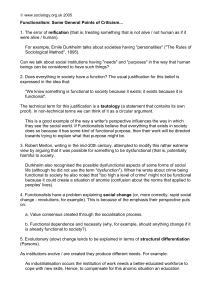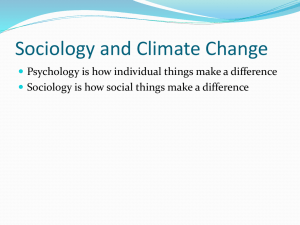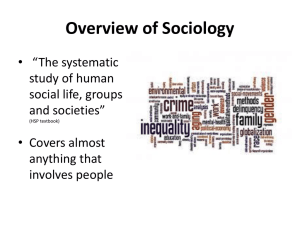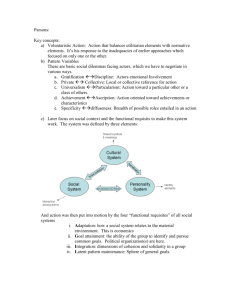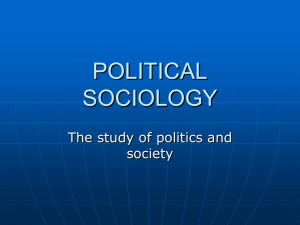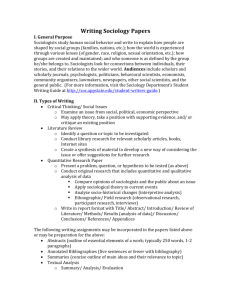Chapter 1: What Is Sociology?
advertisement
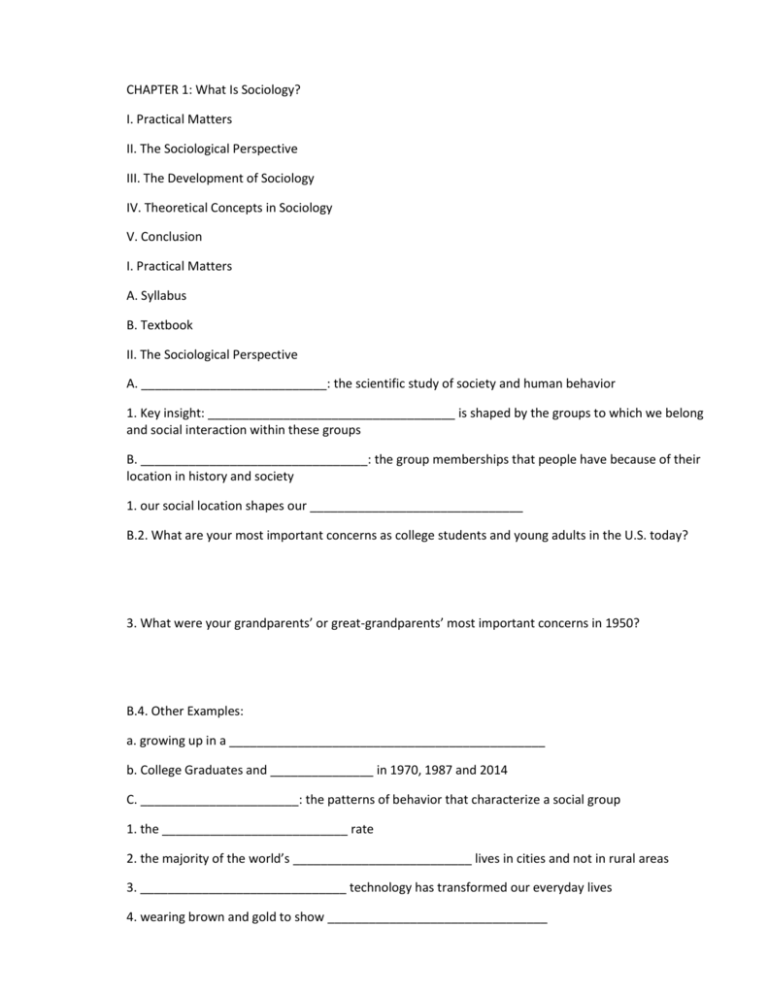
CHAPTER 1: What Is Sociology? I. Practical Matters II. The Sociological Perspective III. The Development of Sociology IV. Theoretical Concepts in Sociology V. Conclusion I. Practical Matters A. Syllabus B. Textbook II. The Sociological Perspective A. ___________________________: the scientific study of society and human behavior 1. Key insight: ____________________________________ is shaped by the groups to which we belong and social interaction within these groups B. _________________________________: the group memberships that people have because of their location in history and society 1. our social location shapes our _______________________________ B.2. What are your most important concerns as college students and young adults in the U.S. today? 3. What were your grandparents’ or great-grandparents’ most important concerns in 1950? B.4. Other Examples: a. growing up in a ______________________________________________ b. College Graduates and _______________ in 1970, 1987 and 2014 C. _______________________: the patterns of behavior that characterize a social group 1. the ___________________________ rate 2. the majority of the world’s __________________________ lives in cities and not in rural areas 3. ______________________________ technology has transformed our everyday lives 4. wearing brown and gold to show ________________________________ III. The Development of Sociology A. Why develop a science of the social world? 1. explain social upheaval in Europe in the 1800s resulting from the _________________ _______________________________ 2. _____________________________ brought Europe into contact with very different societies 3. success of ______________________________ created a desire for knowledge about society B. Karl Marx 1. ___________________________: economic system based on the private ownership of wealth, which is invested and reinvested in order to produce profit 2. ___________________________________ between workers and capitalists (business owners) was the driving force of human history 3. ___________________________________ shape human behavior: capitalists’ social position means they are wealthy, live in large houses, have servants, etc., while workers do not C. Emile Durkheim 1. _______________________________________: the forces that bind people together in groups a. ______________________ solidarity: social ties based on shared beliefs, values and customs in small communities b. ______________________________ solidarity: social cohesion that results from the various parts of a society functioning as an integrated whole; interdependence of people in cities in industrial society ties them together C.2. ____________________________: specialization of work by means of which different occupations are combined within a production system a. today, this is ____________________________________ 3. Why do people commit suicide? a. _____________________: situation in which social norms lose their hold over individual behavior; a lack of social integration into a group; not feeling bound by the rules of society (normlessness) 4. another consequence of anomie: _________________________________ “Nebraska”: Bruce Springsteen I saw her standin’ on her front lawn Just twirlin’ her baton Me and her went for a ride sir And ten innocent people died From the town of Lincoln, Nebraska With a sawed off .410 on my lap Through to the badlands of Wyoming I killed everything in my path I can’t say that I’m sorry For the things that we done At least for a little while sir Me and her we had us some fun The jury brought in a guilty verdict And the judge he sentenced me to death Midnight in a prison storeroom With leather straps across my chest Sheriff when the man pulls that switch sir And snaps my poor head back You make sure my pretty baby Is sittin’ right there on my lap They declared me unfit to live Said into that great void my soul’d be hurled They wanted to know why I did what I did Well sir I guess there’s just a meanness in this world C.5. Charlie Starkweather had no ties to other people or concern with society’s rules: ______________ 6. _____________________________________ and anomie 7. Anomie can result from leaving one social group and joining a new group: What does WMU do about anomie? 8. Does our society promote anomie? D. Max Weber 1. ______________________________: the increasing tendency to organize social life, create bureaucracies to manage large organizations, and write out formal rules of behavior a. ____________________________________ and how we eat b. __________________________ and how we shop E. George Herbert Mead 1. _______________________________________________: emphasizes the role of symbols and language as core elements of social interaction 2. human behavior is determined by a. the _________________________________ of a situation and b. by how people ___________________________________________ 2. How did you know I was the instructor on the first day of class? F. _______________________________: social events can be explained in terms of the functions they perform and how they contribute to the continuity of a society 1. the _________________: function is to reproduce and socialize new members 2. _______________________ functions: functions of a type of social activity that are known to and intended by the individuals involved in the activity a. _______________________: function is to teach skills and knowledge F.3. ___________________________ functions: functional consequences that are not intended or recognized by the members of a social system in which they occur a. universities as ______________________________________ G. ______________________________ theory: emphasizes the centrality of gender to analyzing the social world and particularly the uniqueness of the experience of women 1. why do women earn less than men? 2. why does sexual violence against women occur? IV. Theoretical Concepts in Sociology A. What is a theory? 1. a ______________________ about how some parts of the world fit together and how they work 2. in other words, a way to ______________________ how and why something happens 3. Why did some people stand up to introduce themselves and others did not? A.4. ____________________________ theories about why people do what they do 5. sociology is __________________________________________ to explain social life via theory B. Major Concepts: 1. _____________________________________: the underlying regularities or patterns in how people behave and in their relationships with one another a. e.g. division of society into _______________________________, with wealthy people in mansions and homeless people living in cardboard boxes B.2. ______________________________: the ways in which individuals and groups try to make social life turn out the way they want it to be a. students study hard to get into _________________________ b. job seekers wear nice clothes to _______________________________ B.3. ______________________________________: an idea or practice that a group of people agree exists that is maintained over time by people taking its existence for granted a. wearing brown and gold together is __________________________ b. racial and ethnic __________________________ are defined differently in different societies B.4. __________________________________: interdependence among the parts of a social system a. the ____________________________________ coordinates the actions of students and professors B.5. __________________: the ability of individuals or the members of a group to achieve aims or further the interests they hold, even over the resistance of others a. I have power over ________________ in this class, but my department head has power over me B.6. ______________________________: the language, beliefs, values, norms, behaviors and material objects that are passed from one generation to another a. __________________________________: wearing brown and gold and cheering for sports teams B.7. ____________________________: the social processes through which children develop an awareness of social norms and values and achieve a distinct sense of self a. dressing babies in _____________________ to identify them as female or male V. Conclusion A. What we did today: basic theories and concepts in sociology B. Extra credit for next Thursday: 1. Do something you have not done before 2. Write a 1-page paper about: a. how this activity helped make you feel like a part of WMU b. how being part of this group affected what people did




